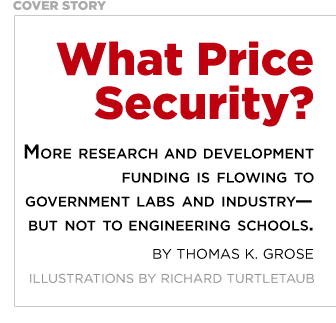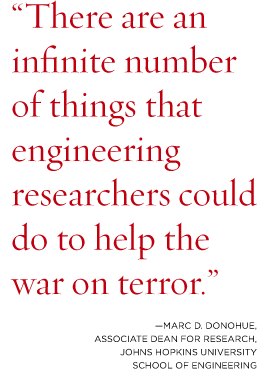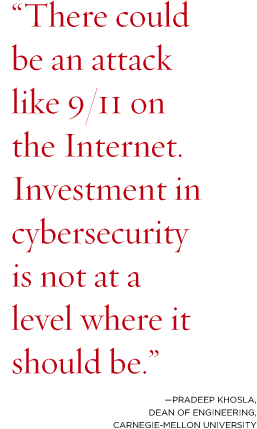What Price Security?

lan Russell, the chemical engineering professor who heads the McGowan Institute for Regenerative Medicine at the University of Pittsburgh, is an expert in the interconnection of chemicals, biology and materials. Most of his work is in the realm of bioengineering and has obvious medical applications. But one of his research areas veers into homeland security and is largely funded by defense agencies. Russell studies the potential use of enzymes to decontaminate the site of a chemical weapon attack. “It’s about how you clean it up: Can you do any better than bleach?” It’s also the kind of research that’s taken on new and heightened relevance since the 9/11 terrorist attacks.
Six years ago this month, Islamic terrorists flying hijacked airliners destroyed the twin towers of New York’s World Trade Center, blew a hole in the Pentagon and crashed a plane in Pennsylvania—killing nearly 3,000 people altogether and awakening America to a serious threat to its homeland. The U.S. response was the global War on Terrorism—a war being fought on many fronts, including the nation’s research labs, which are developing new technologies to detect, combat and mitigate the effects of any future attacks.
Clearly America’s academic engineers, whose many disciplines range from mechanical and electrical to civil and biomedical, could expect to be part of the antiterrorism research campaign.
“Every (engineering) discipline can contribute to homeland security,” says Pradeep Khosla, dean of engineering at Carnegie-Mellon University. Not only that, adds Marc D. Donohue, associate dean for research at the Johns Hopkins University School of Engineering, “there are an infinite number of things that engineering researchers could do to help the war on terror.”
Indeed, in the weeks and months after 9/11, many engineering professors thought there would be a huge demand—and a wave of funding—for security-related academic research. But they were somewhat mistaken: The reality is a very mixed bag.
To be sure, many academic engineers of every stripe are conducting applied and fundamental research with obvious or potential homeland and national security applications. But there has not been a flood of money from federal agencies toengineering academics.
“The perception is, because they are working more on defense-related issues, there is more money. But funding has actually gone down,” says Donohue. Federal spending for homeland security research and development is set to increase 4.4 percent in 2008, to $4.84 billion. But a big portion of that sum won’t require or involve engineering research, or will be funneled to industrial or government labs. Additionally, research and development budgets at some of the agencies most responsible for defense and security research have been pared back. That said, federal agencies—including the National Science Foundation (NSF)—are giving a higher priority to security-oriented research. Meanwhile, many engineering graduate schools capable of conducting such research have been somewhat hamstrung by a post-9/11 clampdown on foreign students.
The threat of terrorism remains very real. Portions of a National Intelligence Estimate (NIE) released by the White House in July warned that over the next three years the U.S. faced a “persistent and evolving terrorist threat,” especially from a “regenerated” al-Qaeda safely sheltered in the hinterlands of Pakistan.
Moreover, the NIE said, globe-spanning technologies enable small numbers of alienated people to communicate with and encourage one another, and gain access to resources. The NIE summary concluded: “The ability to detect broader and more diverse terrorist plotting in this environment will challenge current U.S. defensive efforts and the tools we use to detect and disrupt plots.” In other words, more research to improve our security technologies is clearly needed.
G. Kemble Bennett, vice chancellor and dean of engineering at Texas A&M University, was involved in homeland security before it was called homeland security. Bennett also helped create an urban search-and-rescue unit, Texas Task Force-1, that joined the rescue efforts at Ground Zero in New York. Immediately after 9/11, Bennett says, most anti-terrorism funding went into ensuring that communities were prepared to handle future attacks and into improving intelligence gathering. And those were the correct priorities, he says. Then, in 2003, the Department of Homeland Security (DHS) was created as an umbrella organization to oversee the efforts of several disparate and previously autonomous agencies, with the mission of countering terrorist attacks and responding to natural disasters. That’s a mission that would seem to require a big R&D effort. But expectations that DHS would become some sort of security-oriented NSF with substantial R&D sums to dispense haven’t been fulfilled, Bennett says, “and we’re a long way from getting to that point.”
Multiple Agencies
Initially, DHS’s R&D budget did ramp up quickly, hitting a high-water mark of $1.4 billion in 2006. But most federal homeland security R&D funding goes elsewhere. In fact, the spending is spread over more than a dozen agencies, and only a few of them tend to fund much engineering research. For instance, the agency with the largest homeland security research budget is Health and Human Services, which includes the National Institutes of Health. As for DHS, only a fraction of its research money ends up in university labs, mainly funding eight campus-based centers of excellence, such as the Center for Risk and Economic Analysis of Terrorist Events, which is led by the University of Southern California.
Most DHS research money instead flows into corporate labs. There’s a logic to that, since industrial research is more geared toward meeting the agency’s immediate needs. But Bennett notes that today’s technologies will “go stagnant” if they’re not updated or replaced by new technologies based on cutting-edge academic research. Campus research, he says, also helps train the next generation of engineers working in these areas. For the time being, however, there’s not much DHS money for either industry or academia. Claiming DHS had no clear research goals, Congress slashed the department’s R&D budget 32.5 percent in fiscal 2007 to $948 million. Next year, the department faces another cut of 1.5 percent to $933 million. Only about 4 percent of that money, $39 million, will go to the university centers.
So engineering academics with research projects or ideas that might enhance homeland security must turn to other agencies that typically fund engineering research. But the amounts available aren’t vast. “The NSF has put out a statement saying it is especially interested in projects with security applications,” says David Reed, vice president for research at the Michigan Technological University. And, sure enough, NSF’s homeland security R&D budget is set to jump 28 percent in 2008 to $357 million. Still, that’s not a huge sum compared to its overall anticipated research budget of $6.4 billion. Another traditional booster of engineering research is the Department of Defense (DOD), which controls more than a quarter of the overall homeland security research budget. Its portion is set to jump 8.7 percent to nearly $1.3 billion. But more than half of that will likely go to defense and industrial labs.
Confusing the picture further is the war in Iraq. There’s some overlap between the kinds of research required by the war and the fight against terrorism. As Michigan Tech’s Reed notes, sensors that can pick out human forms in smoky environments are useful to both soldiers on battlefields and American firefighters. But academics with ideas that could benefit both causes also face funding restrictions. Why? The defense agencies’ R&D budgets have been cut to help pay for the cost of fighting the war. DOD’s science and technology budget is set to be sliced 20 percent in 2008 to $10.9 billion. The Army’s research budget is slated for a 3 percent cut to $10.7 billion in 2008, and the Navy’s is facing an 8.3 percent chop to $17.7 billion. The Defense Advanced Research Projects Agency (DARPA) expects a slight cut of 1 percent in its R&D budget to $3.09 billion.
New Research Avenues
Given the nation’s huge emphasis on protection in its multiple forms since 9/11, a funding proposal stands a better chance if it has security applications, some researchers say. For instance, Pitt bioengineer George Stetten’s “sonic flashlight” uses a half-silvered mirror to produce ultrasound images of internal body parts in real time, allowing doctors or nurses to insert scalpels or needles with more precision. His team received NSF funding to work on incorporating holography, radar or other scanning technologies into the device so that it can be used in other environments—such as scanning baggage for weapons or explosives or rubble for buried victims.
But engineering’s potential contribution to the war on terror goes far beyond this example. Engineers could, for instance:
- Design improved bomb-detection devices to help locate potential bombs before they explode, perhaps using computer-vision algorithms
- Invent computer modeling software to calculate areas where terrorists are most likely to plant bombs
- Build robotic vehicles to gather intelligence in areas too dangerous for humans to tread, such as a suspect bomb location, or inside a building damaged by a blast
- Develop telecommunications improvements to make U.S. defense and law-enforcement communications more secure, or to help with efforts to identify, intercept and interpret communications sent by adversaries (including improved voice-identification software)
- Design chemical detectors with multimodality capabilities that can more readily detect poisons
- Use nanotechnology to develop micro-size generators to power sensor networks that protect possible infrastructure targets, like water-treatment plants and power stations
- Create hand-held inspection tools to search for explosives in the more than 20 million shipping containers that reach the United States each year (many current analyzers are too big to haul aboard ships).
The importance of research in combating terror would seem to be underscored by the terrorists’ grasp of the Internet and other technology, as well as by the attention to detail and careful planning demonstrated by the 9/11 attacks. Osama bin Laden himself is reported in a number of accounts to possess a degree in civil engineering.
Even the most security-oriented research isn’t guaranteed funding. Carnegie-Mellon’s Khosla opened a cybersecurity lab, CyLab, a year before 9/11 and initially found it difficult to get grant money. That changed dramatically after the attacks, and there was a big rush of money. But now, Khosla says, “the funding is out there, but it’s harder to get again.” Cybersecurity has been lumped in with all aspects of homeland security, so it has to vie for money against physical security technologies, like the detection of explosives. “That’s very shortsighted,” Khosla says. “There could be an attack like 9/11 on the Internet. Investment in cybersecurity is not at a level where it should be.”
Schools and researchers that have long-standing relationships with defense agencies may have benefited the most from the emphasis on security. For many years, Michigan Tech’s engineering school has gotten most of its federal funding from the DOD, the Department of Energy and the NSF. And it’s seen its research funds double since the terrorist attacks. “Currently, Defense is our biggest source, and that’s been especially true since 9/11,” Reed says.
But at the University of Michigan, “We have not seen an obvious increase in Defense spending for research,” says David Munson, dean of the engineering school. “That’s not to say we don’t have security work—we do. It’s just not dominating the landscape.”
Pitt engineer Russell has also enjoyed a long working relationship with defense agencies; he’s been toiling on chemical weapons detoxification for 15 years. Yet he found that after 9/11, his defense funding didn’t greatly increase, despite heightened interest in the subject.
Applied vs. Basic Research
Does the focus on security-related research mean that applied research is getting more emphasis than fundamental research? Not necessarily. Orlin D. Velev, a chemical engineer at North Carolina State University, says DOD agencies continue to judge proposals as they always have, based on scientific merit. “I’ve never had any strings attached,” Velev says, adding that defense agencies know that all future gadgets and weapons will have to be underpinned by new technologies and principles that only basic research can unearth.
Nevertheless, basic research has undergone a metamorphosis toward the practical, and that’s particularly obvious when it comes to defense. “There’s been a shift from esoteric problems to real problems,” Johns Hopkins’ Donohue says. “More funding is going to interesting science that is solving important problems, not just to science for science’s sake. The bias now is toward solving important societal problems, and you can still do that by doing fundamental research.” Michigan’s Munson agrees: “It is still possible to do basic research without an eye toward an application, but it is a fair statement that the push is toward research that has definite applications.”
DARPA regularly used to fund research that was 10 to 20 years away from bearing fruit. But it is doing less of that today, mainly because of the war and 9/11. “DARPA is much more near-term focused than in the past,” Donohue says. Adds Reed: “It’s difficult to quantify, but anecdotally that seems to be the case. Our DARPA projects are looking for things that can be applied in the near term.”
Impact of Visa Restrictions
Graduate schools have been hit hard by the post-9/11 tightening of student visa regulations. Long delays caused many foreign students to stay away, and both applications and enrollments fell. This was particularly worrisome for U.S. engineering schools. Between 40 and 45 percent of their master’s and nearly 60 percent of their doctoral degree students are foreign.
The visa process has by now been simplified, though Reed notes that “it is still not as easy as it was. It’s gotten better, but there are still a lot of big hoops (students) have to jump through.” The Council of Graduate Schools says that after three years of declines, foreign enrollments at U.S. schools inched up 1 percent in the 2007-08 school year, and engineering enrollments were up 3 percent. Yet in the interim, Munson says, many European and Australian schools began to draw foreign students, particularly those from Asia. “And now they have a pipeline to them.” “The damage has been done,” Munson says.
The extent of damage varies. Some schools, like Johns Hopkins, say that while applications are down, they still receive many more than they can accept. “It’s not reached a crisis point where schools can’t get good students,” Donohue says. But Munson says that while Michigan’s engineering school still has more foreign applicants than places, “in terms of quality of the applicants, I suspect that’s not returned to where we were before.”
Another negative effect of 9/11 for engineering schools is stricter enforcement of laws banning the export of defense-related intellectual property or equipment to foreign countries, particularly the International Traffic in Arms Regulations (ITAR). That means foreign students are barred from some research, and some findings can’t be published. Restrictions can cover not only classified contracts but research deemed “sensitive.”
Munson calls that an overreaction. By not making use of top foreign talent, he claims, “we are shooting ourselves in the foot.” Texas A&M’s Bennett adds that “there is a lot of brilliant (foreign) talent we could bring to bear on these problems, and we can’t go near it.”
At one point, some defense and energy funding agencies were also proposing to extend the reach of export laws into the classroom. In theory, if foreign students (including undergraduates) are taught a process or trained on equipment with potential defense applications, they are essentially “exporting” that knowledge when they return home. Engineering classes in the past were exempt from those laws, but after 9/11 came a rethink. The proposals were pulled back following an outcry from academics, Reed says. “But we may not have heard the end of it yet.”
As the nation reassesses many aspects of its early response to the shock of 9/11, the priority given to national security in research fields has not escaped critical scrutiny.
Last year, John Mueller, an Ohio State University political scientist and national security consultant, published the book, “Overblown: How Politicians and the Terrorism Industry Inflate National Security Threats, and Why We Believe Them.” Mueller argues that America is overreacting to the threat of terrorism, endangering its preeminence as an economic power as well as its civil liberties. While no engineering academic interviewed for this story echoed Mueller’s sentiments, several worry that the emphasis on homeland security and defense research may come at the cost of attention to other pressing matters, like maintaining the United States’ dominance of the microchip industry or combating growing competition from Asia.
In particular, many stress that a bigger security concern than terrorism is America’s reliance on fossil fuels, which contribute to global warming and come from some of the world’s most volatile regions, including the Middle East. Indeed, freeing the United States from its economic dependence on foreign oil could help reduce its exposure to terrorist threats, they argue. Beyond that, of course, known reserves of fossil fuels are dwindling. “There’s going to be (an energy) crisis,” Donohue says. “There will be major energy disruptions in the Western world.”
Nevertheless, Khosla says, talk of making the United States energy independent is just that—talk. “I’ve not seen a critical mass of research programs that will lead us there. It’s mostly hyperbole.” While Bennett would like to see more money spent on security-related academic research, he worries more about the United States failing to develop alternative energy sources and other new technologies. “The biggest threat this country faces is not another major terror attack,” Bennett says, “but the loss of our standard of living.”
Thomas K. Grose is a freelance writer based in Great Britain.
Category: Cover Story Features


